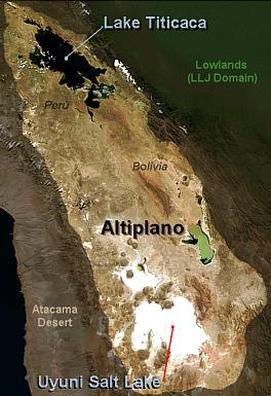High Andean Plateau herpetofauna.

The tropical Andes are considered the pump of plant and avian amazonian diversity.
Right in the middle; the Altiplano-Puna is the elevated continental plateau (~3800 m; 12 000ft) that stretches for 1800 km along the Central Andes and attains a maximum width of 350–400 km.
Usually characterized as an area of low diversity, it probably is also fair to characterize it as an area of high disparity. For example, the diversity of rodents and lizards is probably higher here than in any other dry neotropical region. Similarly, though the diversity of amphibians is significantly higher in the Andes eastern piedmont and tropical amazon, high andean amphibians show high levels of endemism and at a much more smaller spatial scale.
The problem is, we have, once more, very little knowledge of how past landscapes and climate fluctuations have affected biogeographic processes in this area of the world. There is really no hypotheses available to explain diversification processes at any timescale in the high Andean Plateau.
Dr. J. Salazar-Bravo (mammologist at Texas Tech University) and I, have collaborated to write a proposal to spearhead studies of comparative phylogeography focusing on high Andean plateau mice and lizards. He is the PI of a new research proposal submitted to NSF this past Jan 24. Hopefully something comes out of this initiative. In the meantime I have kept an interest in developing the alpha taxonomy of this region. I was fortunate in participating in the description of two species of Telmatobius; T. fronteriensis and T. vilamensis (see accompanying pages).
Right in the middle; the Altiplano-Puna is the elevated continental plateau (~3800 m; 12 000ft) that stretches for 1800 km along the Central Andes and attains a maximum width of 350–400 km.
Usually characterized as an area of low diversity, it probably is also fair to characterize it as an area of high disparity. For example, the diversity of rodents and lizards is probably higher here than in any other dry neotropical region. Similarly, though the diversity of amphibians is significantly higher in the Andes eastern piedmont and tropical amazon, high andean amphibians show high levels of endemism and at a much more smaller spatial scale.
The problem is, we have, once more, very little knowledge of how past landscapes and climate fluctuations have affected biogeographic processes in this area of the world. There is really no hypotheses available to explain diversification processes at any timescale in the high Andean Plateau.
Dr. J. Salazar-Bravo (mammologist at Texas Tech University) and I, have collaborated to write a proposal to spearhead studies of comparative phylogeography focusing on high Andean plateau mice and lizards. He is the PI of a new research proposal submitted to NSF this past Jan 24. Hopefully something comes out of this initiative. In the meantime I have kept an interest in developing the alpha taxonomy of this region. I was fortunate in participating in the description of two species of Telmatobius; T. fronteriensis and T. vilamensis (see accompanying pages).
